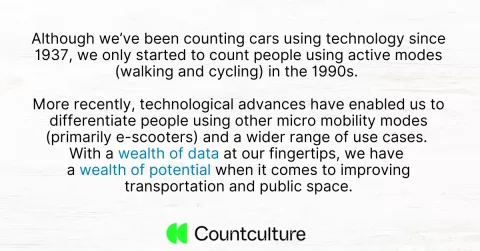
Although we’ve been counting cars using technology since 1937, we only started to count people using active modes (walking and cycling) in the 1990s. More recently, technological advances have enabled us to differentiate people using other micro mobility modes (primarily e-scooters) and a wider range of use cases. With a wealth of data at our fingertips, we have a wealth of potential when it comes to improving transportation and public space.
Collecting traffic data on all our road users helps transport professionals understand, predict, and enhance the real-life impacts of our projects. This can impact how we allocate space to each mode (the design of our public space) and help build the case for further investment.
Data collection can also help in pursuing funding applications and supporting sustained development of capital and operational programmes to support pedestrian and cycle growth. Monitoring is also a requirement to receive National Land Transport Programme (NLTP) funding. According to the NZ Transport Agency (2014) Investing in Cycling, “programme information needs to clearly identify …baseline figures on usage and safety and proposed monitoring of change”. Monitoring is also required by the Department of Internal Affairs and for reporting to Waka Kotahi through the Te Ringa Maimoa Transport Excellence Partnership (formerly, the Road Efficiency Group), including on:
- Condition of footpaths
- Expenditure on walking and cycling, road safety promotion
- Fatal and serious injuries for people walking and cycling
- Length of the cycleway network by urban and rural split
The data is presented through Waka Kotahi’s Transport Insights Web Portal. Starting in 2023, count data is also to be factored into a national multi-modal network model including flows by mode. The fact that having good data on hand is not just useful, but required by these various bodies, means the quality of the data collected is vital. Beyond requirements, it is clear that the data we collect, and how accessible that data is, can have a determining impact on positive behavioural change, like – as this paper will focus on – encouraging people to consider walking or cycling. Accuracy, therefore, is a crucial factor.



